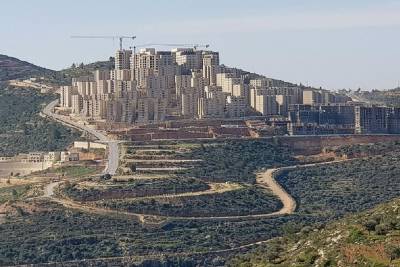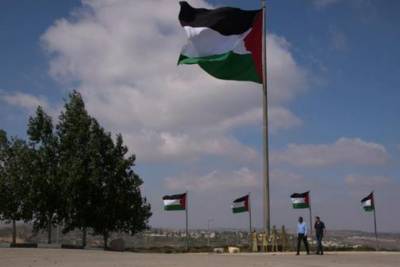Rebecca Coulson: Is Rawabi for real?
Conservative Home - Rebecca Lowe - During the Paris climate change summit, Binyamin Netanyahu and Mahmoud Abbas were photographed together, shaking hands and smiling. This doesn’t happen very often. Following months of stabbings, fighting, and increased tension between Israelis and Palestinians, the encounter sparked an unwarranted moment of global excitement. Having spent almost six weeks in Israel and the West Bank recently, I came away only more aware of the entrenched nature of the divide. Unprecedented summer dust clouds had descended – blown as sandstorms from Syria - and the brightness of real collaboration rarely broke through.
Could emerging proposals for another new Palestinian city in the West Bank be seen in that rare light? In August, I visited its forerunner, the much-lauded Rawabi. And I think about it regularly – its responsibility as a beacon of promise, the struggles it faces, and how some of the things that confused me then still do now.
The floor shakes in just one of its cinemas: the other six are merely 3D. But the film was classic top-end sales pitch. Disney-esque music accompanied the cartoon perfection of a hundred varieties of show home, and a tangible paper aeroplane guided me, red-and-green bespectacled, from kitchen to shopping mall. The screening took place in a futuristic exhibition centre, along a corridor with undulations to replicate the topography outside. Water features were planned for ‘the plaza’, a giant plastic snowman sat by a hedgerow, and there was talk of a car track down in the valley. A 12,000-seat amphitheatre was plastered with ten-foot pictures of Marilyn Monroe and Elvis – although that wasn’t 4D, either. And I assume its audiences will pray it never shakes.
Rawabi’s million square metres of hi-tech living space felt like a Gulf development, which is unsurprising, considering most of its funding comes from Qatar. It’s the largest – private or public sector – project in the Palestinian Territories, ever. By 30 times, I was told. And, as the first ‘planned’ conurbation, there are swollen hopes it will address what its mastermind, Bashar Masri, described as ‘the population issue’. Nearly half of Palestinians are younger than 20, and the average birth rate is five; regardless of politics, housing is a problem.
But Rawabi is clearly aimed at high earners. Whilst its promoters insisted that apartments were selling at somewhere between £50,000 and £150,000 (figures constantly repeated in the press) – comparatively cheap in the area – this surely can’t make them generally affordable. American-run schemes are no replacement for an accessible ‘national’ mortgage framework, and the mean Palestinian wage is £14,500, and often much less. The city’s focus on fibre optics and outdoor exercise machines seemed, therefore, even harder to square with the poverty usually displayed in parts of the West Bank (although I drove past Abbas’s new £9 million palace in Ramallah), and Gaza.
Of course, the idea is for Rawabi to kick-start the local economy, and – as it allegedly now has – inspire similar enterprises. Yet, whilst people talked of its need to provide long-term jobs – ‘It won’t be a bedroom community!’ – there was little explanation of what these would be, outside the realm of self-sufficient subsistence. Apparently the intention is to fight against Israel in the start-up market. ‘Our literacy rate means we have much to offer,’ someone told me, claiming the vast majority of Palestinians who completed school went on to higher education; youth literacy is, indeed, over 98 per cent. But 51 per cent of graduates are unemployed. The boss of a global soft drinks franchise boasted about having funded accelerators and team bonding meetings: this didn’t come across as very concrete.
Everyone says that Rawabi is impressive and positive. OK, it’s provoking protest from those opposing ‘normalisation’, yet its acceptance of Israeli companies’ investment was essential, and feels more encouraging than a televised handshake. Maybe it’s simply the collapsing Palestinian economy – instead of the desire for a contrary political narrative – that has, so far, prevented its government from honouring the pledge of an £100 million contribution (a sizeable portion of a forecast £560 million cost, which has risen to £800 million). And it’s easy to be convinced that the endless bureaucracy of being surrounded by Area C land (completely controlled by Israel) has exacerbated delays, not least regarding access roads and water supplies.
None of this was what I found most confusing, however. It was the lack of people. Was there anyone around, apart from politicians in suits, and a couple of guys aimlessly hauling stones back and forth? Supposedly, its projected 40,000 inhabitants had started moving in the previous month. I was told that families were living there, but where were they? It made the show homes seem more of a show, and Rawabi’s promise more of a political – rather than pragmatic – dream.
This view felt cynical, though, and I wanted to be wrong. A few months later, I’m still unsure. A friend tells me that about a hundred people have moved in since I visited: online reports aren’t exactly illuminating. Several say that keys have been handed over to as many as 640 families, some claim a dozen have settled in, and most now tout September as when this began. I’ve become one of @RawabiCity’s 795 followers, and I’ve seen more of the same elegant buildings, read more of the same sales talk, and imbibed more of the same optimism. But is it actually working? Is it for real yet? Will its successor cities be? I really hope so.
To view original article, Click Here.



